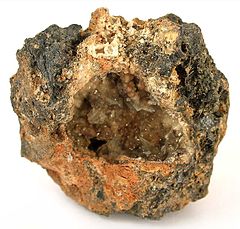Leadhillite
| Leadhillite | |
|---|---|

Thin crystals of transparent leadhillite, inside a vug of galena which seems to be partially altered to cerussite. From the type locality, Leadhills, South Lanarkshire, Scotland. Size: 5.3 x 5.1 x 4.4 cm.
|
|
| General | |
| Category | Carbonate minerals |
|
Formula (repeating unit) |
Pb4SO4(CO3)2(OH)2 |
| Strunz classification | 5.BF.40 |
| Dana classification | 17.1.2.1 |
| Crystal system | Monoclinic |
| Crystal class | Prismatic (2/m) (same H-M symbol) |
| Space group | P21/a |
| Unit cell | a = 9.11, b = 20.82 c = 11.59 [Å]; β = 90.46°; Z = 8 |
| Identification | |
| Formula mass | 1,078.90 g/mol |
| Colour | Colourless to white, grey, yellowish, pale green to blue |
| Crystal habit | Usually pseudo-hexagonal, thin to thick tabular {001} with hexagonal outline |
| Twinning | Commonly twinned, twin plane {140} |
| Cleavage | Perfect on {001} |
| Fracture | Irregular to conchoidal |
| Tenacity | sectile |
| Mohs scale hardness | 2½ to 3 |
| Lustre | Adamantine, resinous, pearly |
| Streak | White |
| Diaphaneity | Transparent to translucent |
| Specific gravity | 6.55 |
| Optical properties | Biaxial (-) |
| Refractive index | nα = 1.87, nβ = 2.00, nγ = 2.01 |
| Birefringence | 0.140 |
| 2V angle | 10° |
| Dispersion | Strong, r<v |
| Ultraviolet fluorescence | Yellowish fluorescence in LW or SW UV |
| Solubility | Soluble in HNO3 |
| Alters to | Galena, calcite and susannite may alter to leadhillite. Leadhillite may alter to cerussite, calcite and susannite |
| Other characteristics | Not radioactive |
| References | |
Leadhillite is a lead sulfate carbonate hydroxide mineral, often associated with anglesite. It has the formula Pb4SO4(CO3)2(OH)2. Leadhillite crystallises in the monoclinic system, but develops pseudo-hexagonal forms due to crystal twinning. It forms transparent to translucent variably coloured crystals with an adamantine lustre. It is quite soft with a Mohs hardness of 2.5 and a relatively high specific gravity of 6.26 to 6.55.
It was discovered in 1832 in the Susannah Mine, Leadhills in the county of Lanarkshire, Scotland. It is trimorphous with susannite and macphersonite (these three minerals have the same formula, but different structures). Leadhillite is monoclinic, susannite is trigonal and macphersonite is orthorhombic. Leadhillite was named in 1832 after the locality.
Leadhillite belongs to the monoclinic crystal class 2/m, which is the class with the highest symmetry in the monoclinic system. It has a two-fold axis of symmetry perpendicular to a mirror plane, and the general form is an open-ended prism. The space group is P21/a, meaning that the two-fold axis is a screw axis and the mirror plane is a glide plane. There are 8 formula units per unit cell (Z = 8) and the angle β is very nearly equal to 90°. The side-lengths of the unit cell are a = 9.11 Å, b = 20.82 Å and c = 11.59 Å.
...
Wikipedia
